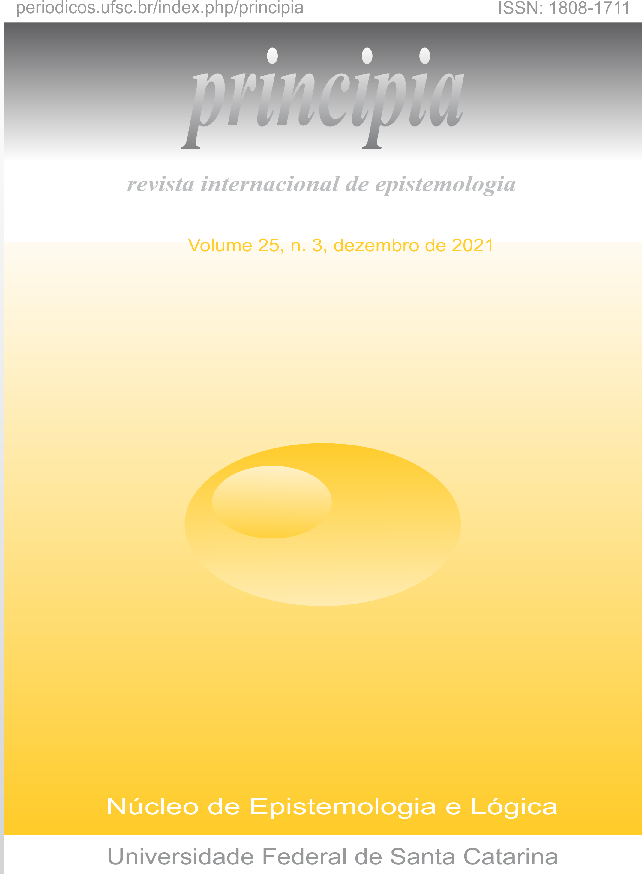Causality in the Philosophy of Medicine and of Epidemiology
DOI:
https://doi.org/10.5007/1808-1711.2021.e74077Abstract
Epistemological analysis of the health sciences practices has recently become more present in the philosophical debate over the last decades, and it is crucial in the dramatic context of the pandemic in which we currently live. Contributing to this analysis, this article presents an introduction to the themes approached in philosophy of medicine and in philosophy of epidemiology, especially the exam of the role of causality, which is of fundamental importance for the understanding of the relation between health and disease. The notion of INUS cause, proposed by the philosopher J. L. Mackie and adapted to epidemiology by Kenneth Rothman, allows the precise depiction of the multicausal interactions that co-operate to the alteration of a state of health. However, Rothman's model does not encompass important concepts of epidemiology. This is an imprecision that I aim to mend by proposing a temporal representation of the multicausal set that, among other things, allows for the planning of accurate interventions, focusing on preventing the installation of a disease. The delimitation of the causal set is also called into question, since the multicausal perspective does not intrinsically delimit any criterion on where to finalize the selection of causal factors. I point to manipulability as the health sciences' characteristic approach to the selection of factors in which to intervene, and that the recognition of this perspective is important for the philosophical understanding of causality itself.
References
Almeida Filho, N. 1992. Epidemiología sin números. Organización Panamericana de la Salud. Washington: Serie Paltex
Almeida Filho, N. & Rouquayrol, M. 2008. Introducción a la epidemiologia. Buenos Aires: Editora Lugar.
Arruda, R. 2021. Multicausalidade e Manipulação na Medicina. In: Perspectivas sobre o método científico. Seropédica: Editora do PPGFIL/UFRRJ. https://www.editorappgfilufrrj.org/pdfs/
perspectivas_metodo_cientifico.pdf. Acesso: 26/11/2021.
Bonita, R.; Beaglehole, R. & Kjellström T. 2010. Epidemiologia básica. Organização Mundial da Saúde. São Paulo: Santos. http://apps.who.int/iris/bitstream/10665/43541/5/9788572888394_por.pdf. Acesso: 21/08/2021.
Cartwright, N. 2007. Hunting Causes and Using Them: Approaches in Philosophy and Economics. Cambridge: Cambridge UP.
CDC/Centers for Disease, Control and Prevention. 2016. About HIV/AIDS. Atlanta: U.S. Department of Health & Human Services. https://www.cdc.gov/hiv/basics/whatishiv.html . Acesso: 21/08/2021.
Chisholm, R. 1946. The Contrary-to-Fact Conditional. Mind, New Series, 55(220): p. 289-307.
Criado, P., Criado, R., Maruta, Celina W. et al. 2005. Urticaria. An Bras Dermatol. 80(6): 613-32.
Evans, A. 1978. Causation and disease: a chronological journey. The Thomas Parran Lecture. American journal of epidemiology. 108(4): 249-58.
Gaetano, P. 2018. The British Doctors’ Study (1951–2001). Embryo Project Encyclopedia
Garg, S., Kim L., Whitaker, M. et al. 2020. Hospitalization Rates and Characteristics of Patients Hospitalized with Laboratory-Confirmed Coronavirus Disease 2019 — COVID-NET, 14 States, March 1–30, 2020. US Department of Health and Human Services/Centers for Disease Control and Prevention 69(15): 458-464.
Goodman, N. 1947. The Problem of Counterfactual Conditionals. The Journal of Philosophy, 44(5): p. 113-128.
Hempel, C. 1974. Filosofia da ciência natural. Rio de Janeiro: Zahar Editores.
Hill, A B. 1965. The environment and Disease: Association or Causation? Proceedings of the Royal Society of Medicine. 58(5): 295-300.
Holland, P. 1986. Statistics and Causal Inference. Journal of the American Statistical Association. 81(396): 945-960.
Lewis, D. 1973. Causation. The Journal of Philosophy, Seventieth Annual Meeting of the American Philosophical Association Eastern Division, 70(17): p. 556-567.
Mackie, J. L. 1965. Causes and Conditions. American Philosophical Quarterly 2(4): 245-264.
Mackie, J. L. 1980. The Cement of the Universe. Oxford: Clarendon Press.
Mill, J. S. 1882. A system of logic. Eighth Edition. New York: Harper & Brothers, Publishers.
Rothman, K. 1976. Causes. American Journal of Epidemiology 104(6): 587-92.
Rothman. K. 1981. Induction and latent periods. American Journal of Epidemiology 114(2): 253-259.
Rothman, K. & Greenland, S. 2005. Causation and Causal Inference in Epidemiology. American Journal of Public Health 95(S1): S144-S150.
Rothman, K., Greenland, S., Lash, T. et al. 2008. Causation and causal inference. Modern Epidemiology 3º edition. Philadelphia: Wolters Kluwer Health/Lippincott Williams & Wilkins.
Scriven, M. 1964. The Structure of Science. The Review of Metaphysics 17(3): 403-424.
Siebenhaar F., Weller, K., Mlynek A., Magerl, M. et al. 2007. Acquired cold urticaria: clinical picture and update on diagnosis and treatment. Clinical and Experimental Dermatology 32: 241-245.
Simon, V. 2005. Wanted: Women in Clinical Trials. Science 308(5728): 1517.
Tan, L., Wang, Q., Zhang, D. et al. 2020. Lymphopenia predicts disease severity of COVID-19: a descriptive and predictive study. Signal Transduction and Targeted Therapy 5(33): 1-3.
Wang, X., Xu, W., Hu, G. et al. 2020. SARS-CoV-2 infects T lymphocytes through its spike protein-mediated membrane fusion. Cell Mol Immunol. Letter: 1-3.
Woodward, J. 2003. Making Things Happen: A Theory of Causal Explanation. Oxford University Press. Oxford.
Woodward, J. 2013. Causation and Manipulability. The Stanford Encyclopedia of Philosophy (Winter Edition), Edward N. Zalta (ed.).
World Health Organization. 2015. Guideline on when to start antiretroviral therapy and on pre-exposure prophylaxis for HIV. WHO Library Cataloguing-in-Publication Data. Switzerland. https://apps.who.int/iris/bitstream/handle/10665/186275/9789241509565_eng.pdf. Acesso: 21/08/2021.
Downloads
Published
Issue
Section
License
Copyright (c) 2021 Renata Arruda

This work is licensed under a Creative Commons Attribution-NonCommercial-NoDerivatives 4.0 International License.

Principia http://www.periodicos.ufsc.br/index.php/principia/index is licenced under a Creative Commons - Atribuição-Uso Não-Comercial-Não a obras derivadas 3.0 Unported.
Base available in www.periodicos.ufsc.br.



